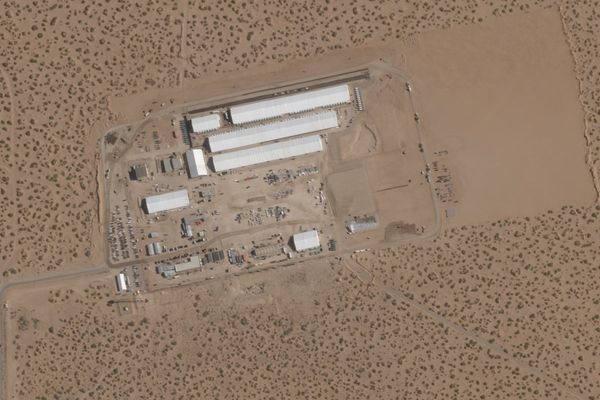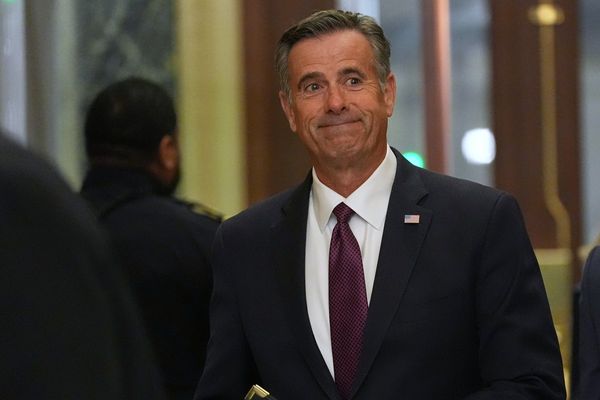Australian shares have risen to their highest level in 10 weeks, following gains on Wall Street, despite renewed concerns about China's economy leading to a fall in oil and iron ore prices.
The ASX 200 index closed 0.5 per cent higher, at 7,105 points. The last time it traded at this level was back in early June.
The worst performer on the benchmark index was was investment manager Challenger, which shed 10.1 per cent in its worst session since April 2021.
Challenger reported that its its full-year profit had dropped 57 per cent to $254 million, driven by unrealised investment losses.
The company also said it was reviewing the status of its loss-making division, Challenger Bank (formerly known as MyLifeMyFinance), which it acquired for $35 million in December 2020 from Catholic Super.
Meanwhile, Seek was down 5.1 per cent to $23.12, after the online job board announced a full-year profit of $245.5 million, which fell below analysts' expectations.
On the flip side, shares in Temple & Webster soared 29.8 per cent (to a four-month high of $5.71).
This was after the online furniture retailer announced its full-year revenue rose 31 per cent to $426.3 million, and upgraded its margin guidance for the current financial year.
BHP's second-highest profit
BHP has announced its second-highest annual profit ever, thanks to record sales at its Western Australian iron ore operations and strong commodity prices, but warned of rising costs from a tight labour market in the current financial year.
The largest miner, by market value, on Tuesday announced a final dividend of $US1.75 per share.
That takes its annual dividend up to $US3.25 per share, its highest payout ever — at a time when miners have cut investor returns to contend with declining profits.
The miner posted its highest profit since 2011, with underlying profit from continuing operations (for the year ended June 30) rising 26 per cent, to $US21.32 billion.
On a different measure, its full-year attributable profit surged 173 per cent to $US30.9 billion.
Prices of major commodities like copper have hovered near record highs, while coal prices have soared since Russia's invasion of Ukraine left potential buyers scrambling for alternatives.
The miner's performance at its Western Australian iron ore operations also helped offset a drop in prices of the steel-making commodity from last year's record levels as China's push to curb emissions and easing construction activity in the country's debt-laden property sector curtailed demand.
"We expect China to emerge as a source of stability for commodity demand in the year ahead, with policy support progressively taking hold," BHP's chief executive Mike Henry said.
BHP also warned of a slowdown in advanced economies as monetary policy tightens as well as ongoing geopolitical uncertainty and inflationary pressures.
Labour constraints that have plagued production of miners world over will continue to put pressure on global and local supply chains, Mr Henry said.
The company's share price rose 4.1 per cent, to $40.51.
James Hardie's profit downgrade
James Hardie Industries lowered its full-year profit forecast range, citing inflationary pressures globally and uncertainly in the housing market.
Rising interest rate hikes have also weighed on demand for the company's building materials as the housing market is one of the sectors most sensitive to these increases.
The company said significant inflationary pressures across almost all its categories resulted in higher production and distribution costs, with freight, pulp, natural gas, labour, and cement having the greatest impact on gross margin.
The fibre cement maker now expects its adjusted net profit to be around $US730 million to $US780 million for the current financial year.
It was a steep downgrade from its previous estimate of $US740 million to $US820 million.
Chief financial officer Jason Miele attributed the cut in outlook mainly to "continued inflationary pressures, our lowered expectations regarding Europe segment EBIT [earnings before interest and tax], the impact of a strengthening US dollar on the translation of our APAC [Asia Pacfic] and Europe earnings and housing market uncertainty."
It recorded an adjusted net operating profit of $US154.3 million in the first quarter, up from $US134.2 million a year ago.
Net sales came in at $US1 billion, up 19 per cent from last year, with its North America segment contributing $US740.1 million.
James Hardie's share price fell 0.9 per cent, to $36.35.
Tassal accepts $1.7 billion takeover bid
Tassal Group has accepted a sweetened $5.23 per share takeover offer from Canadian aquaculture company Cooke Inc, giving the Australia-based salmon producer an enterprise value of $1.7 billion.
The deal will give Cooke access to Tassal's salmon farms spanning five marine zones, four freshwater hatcheries and four processing facilities in Tasmania, as well as prawn farming and seafood processing businesses in New South Wales and Queensland.
The agreement comes after Tassal previously rejected two earlier proposals from the Canadian firm, stating that the offers failed to reflect the fundamental value of its business.
The latest deal price was a 7 per cent premium to Tassal's last closing price and above Cooke's last offer of $4.85 per share.
The board unanimously recommended shareholders vote in favour of the offer at a meeting to be held in November, the Australian salmon farmer said.
The scheme is not subject to any financing or due diligence conditions, and Cooke has advised that it has already obtained Foreign Investment Review Board approval for the deal, the company added.
Tassal's share price jumped 5.1 per cent, to $5.14.
'Bad sign' for the Aussie dollar
The Australian dollar was trading at 70.2 US cents, by 4:25pm AEST. This was after it suffered a 1.4 per cent fall overnight.
"The weakness in the US and Chinese economies is typically a bad sign for commodity currencies such as the Australian, New Zealand and Canadian dollars because of their economies' exposure to commodity prices," said Joseph Capurso, head of international economics at Commonwealth Bank.
Oil prices tumbled after disappointing Chinese retail and industrial production figures renewed concerns of a global recession that would be expected to reduce fuel demand.
Brent crude futures fell 4.5 per cent to $US93.69 a barrel.
Gold fell sharply amid sharp declines across precious metals due to a stronger US dollar, with concerns over further rate hikes by the US Federal Reserve adding to pressure on bullion.
Spot gold dropped 1.3 per cent to $US1,779 an ounce.
Iron ore fell 1.9 per cent to $US107.60 a tonne.
On Wall Street, the S&P 500 gained 0.4 per cent, to end at 4,296 points. The Nasdaq Composite gained 0.6 per cent to 13,124, while the Dow Jones index rose 0.4 per cent to 33,904.
Stocks extended gains from last week when signs that inflation may have peaked in July increased investor confidence that a bull market could be underway.
The S&P 500 has rebounded sharply since mid-June but remains down for the year.
China's surprise interest rate cut
The People's Bank of China unexpectedly cut key interest rates on Monday after the world's second-largest economy reported July data on industrial output and retail sales that missed most analyst estimates.
The PBOC said it was lowering the rate on 400 billion yuan ($84 billion) worth of one-year medium-term lending facility (MLF) loans to some financial institutions by 0.1 percentage points, to 2.75 per cent.
China's strict COVID-19 restrictions have hobbled activity at its main manufacturing hubs and popular tourist spots, including Shanghai, even as a deepening downturn continues in the property market.
Industrial output grew 3.8 per cent in July from a year earlier, according to the National Bureau of Statistics (NBS), below the 3.9 per cent expansion in June and a 4.6 per cent increase expected by analysts in a Reuters poll.
Retail sales, which only just returned to growth in June, rose 2.7 per cent from a year ago, missing forecasts for 5 per cent growth and the 3.1 per cent growth seen in June.
"You've been seeing a slowing trend in China amplified by the lockdowns," said Tom Plumb, portfolio manager at Plumb Balanced Fund in Wisconsin.
"The credit problems they've had, especially with real estate developers — that's going to tie their hands for how aggressive they can go back to stimulation.
"But I think it's a sign they're going to try to be more accommodative."
ABC/AAP/Reuters







